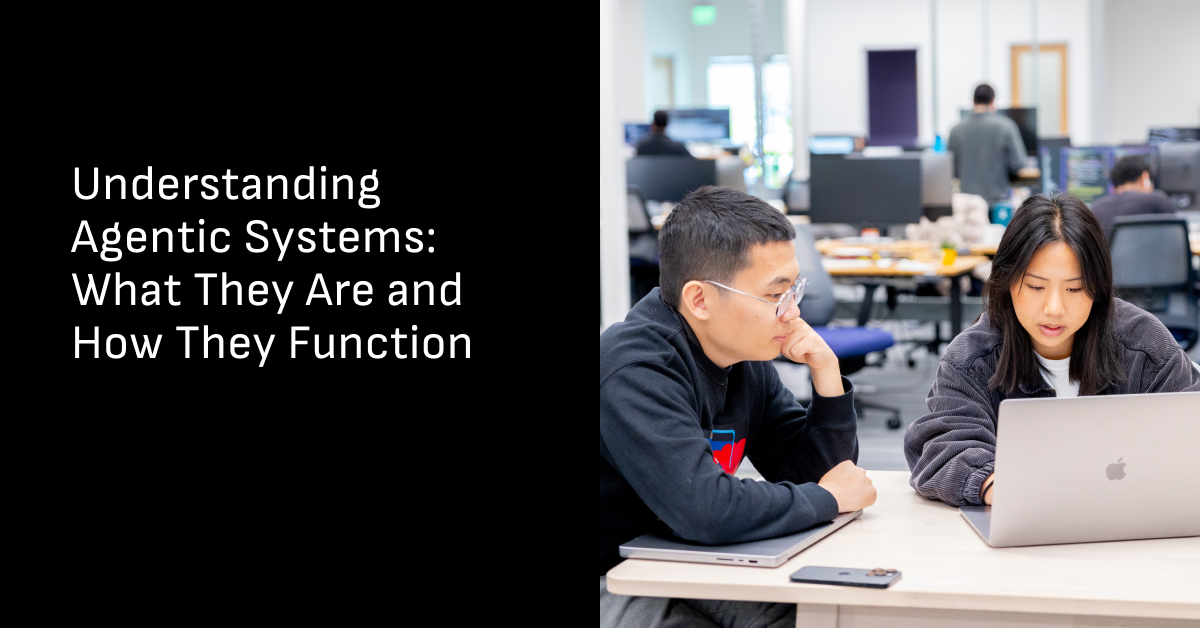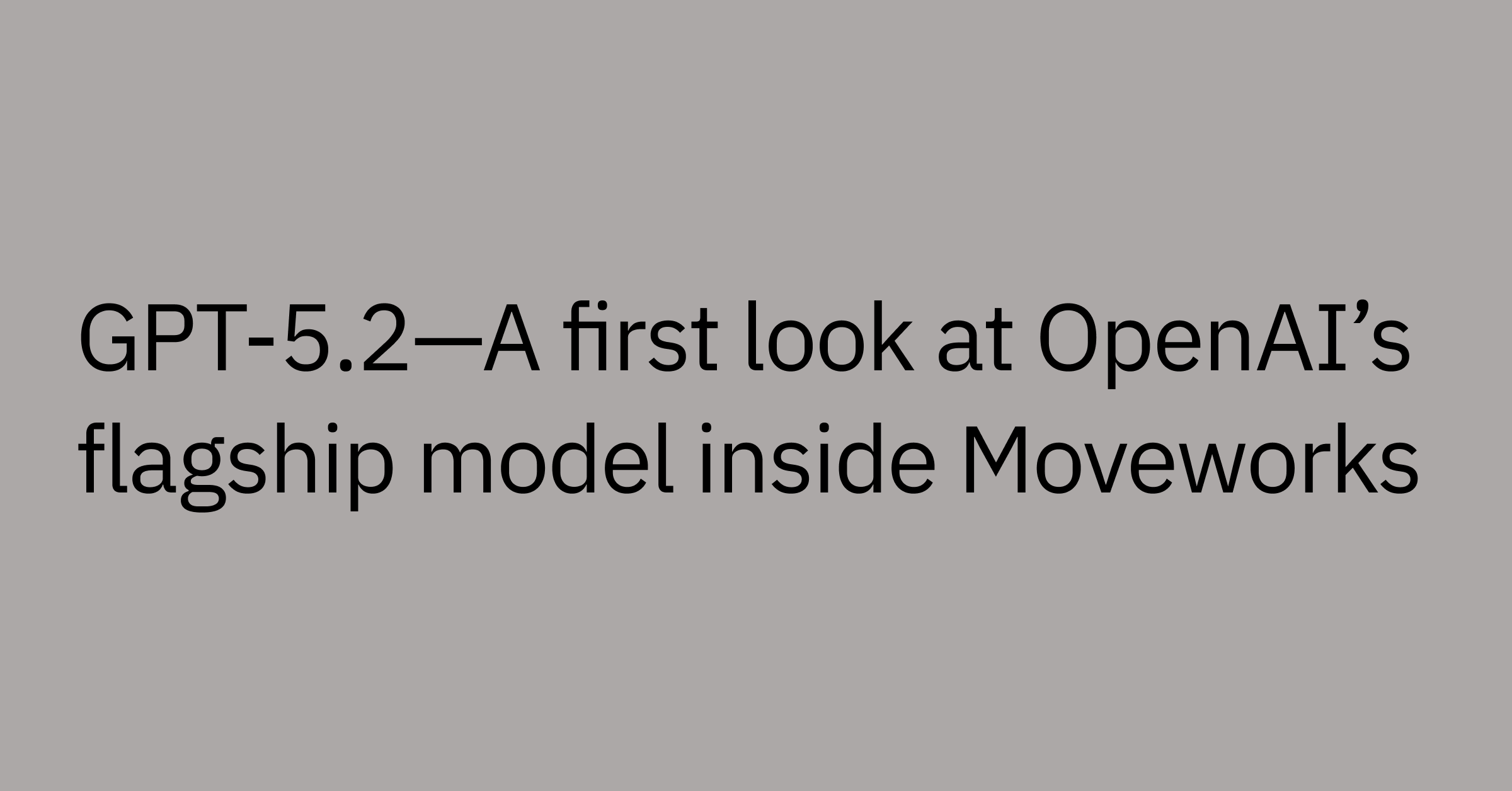Table of contents
When an employee at a fast-growing company needs access to a new software tool, normally, they’d submit a ticket, wait for IT to approve it, and then hope the right permissions get assigned — sometimes waiting hours or even days.
But what if, instead, an AI system could understand the request, check compliance, get manager approval, and grant access?
This is the power of agentic AI.
While generative AI has been making headlines for its ability to generate text, images, and code, agentic systems are changing the game by taking action too.
Agentic systems use AI to go beyond just answering questions – they can also understand your goals, make decisions and execute tasks.
The UC Berkeley Sutardja Center for Entrepreneurship and Technology (SCET) calls agentic systems the "next big opportunity" for improving efficiency and cutting costs across key business processes — as long as businesses carefully manage potential risks.
So, what exactly are agentic systems, and how are they different from the artificial intelligence (AI) you already know? Think of them as more than just AI tools.
Agentic AI systems don’t just think and generate responses — they act too. They combine AI’s ability to learn and reason with real-world interactions, making them a powerful step forward in automation.
From chatbots to agentic AI: A brief history
The journey toward agentic systems has seen some major milestones in AI development.
Back in the early 2010s, we had rule-based chatbots that could handle basic interactions but were pretty rigid. If you didn’t phrase your command just right, they wouldn’t understand.
Things took a big step forward in the late 2010s with the rise of large language models (LLMs). These advanced AI models brought advanced natural language understanding and generation abilities.
These AI systems could generate human-like text and even answer questions more contextually.
LLMs’ complex reasoning performance has improved significantly since 2021, paving the way for even more advanced systems.
The next breakthrough came with foundation models and generative AI — large neural networks trained on extensive datasets to handle tasks like language comprehension, text/image generation, and natural language conversations.
But even these systems had limits. They could generate responses but couldn’t take independent action or interact with other systems on their own.
Traditional AI systems, including more powerful ones, faced key challenges:
- They couldn’t understand context beyond their training data.
- They struggled to interact with external systems or environments.
- They lacked reasoning and autonomous decision-making abilities.
- They couldn’t learn from or adapt based on real-world interactions.
These limitations have led to the rise of smarter, more independent AI systems that are already pushing past these boundaries.
What is an agentic system?
An agentic system is the next big step in enterprise automation. It combines the reasoning power of LLMs with the ability to take action across different platforms and systems.
Agentic systems can tackle complex problems, create multi-step plans, and take action across different platforms and systems. Imagine an AI that can:
- Solve complex problems
- Create and execute multi-step plans
- Continuously optimize workflows
- Learn and improve with every interaction
Sounds like the future? It’s already happening.
Gartner has listed agentic AI as one of the top tech trends for 2025. By 2028, 33% of enterprise software is expected to rely on agentic AI, with some projections showing that at least 15% of everyday work decisions will be made with such systems.
Explore the ROI potential for implementing your own agentic system.
Core components of an agentic AI system
An agentic system is made up of several smart components working together to deliver intelligent automation. Here’s a breakdown of its main elements.
1. AI agents and types: The building blocks of an agentic system
AI agents are at the heart of an agentic system, each designed to handle specific tasks — many of which were traditionally performed by humans. These agents vary in complexity and can be grouped into a few key types:
- Reactive agents: These agents focus on immediate responses using current input, without keeping track of past data. Think of a smart thermostat that automatically turns on when the temperature drops below a set level.
- Deliberative agents: These agents use past experiences and predictive analysis to make better decisions. A great example is Google Maps, which analyzes real-time traffic, historical congestion patterns, and possible detours to suggest the fastest route.
- Learning agents: AI assistants that get smarter over time by learning from user experiences and feedback. The more people use them, the better these agents understand context, intent, and provide more accurate answers.
- Collaborative agents: These agents work together to tackle complex, multi-step challenges that require diverse skills.
For example, self-driving cars rely on multiple AI agent models working in sync to track objects, predict movements, and make split-second driving decisions.
2. Agentic framework: The system’s backbone
The agentic framework creates a structure that helps all these components work together seamlessly. Agentic frameworks, or agentic architectures, set the rules, protocols, and interfaces for agentic systems. Agentic frameworks enable builders to create multi-agent systems. Such frameworks help to ensure consistency and integration across different components and systems. These help agents to:
- Communicate and collaborate effectively
- Follow a structured decision-making process
- Integrate with different applications and enterprise systems
- Adapt to new tasks and environments dynamically
Without being built off of such frameworks, agentic AI would struggle to function as a cohesive system. Using these frameworks is what enables these smart agents to not only think and learn but also take action in an organized, efficient way.
What differentiates an agentic system from a non-agentic system?
The real strength of agentic systems is their ability to bring together multiple advanced features to make reasoning – and taking autonomous action – possible. Unlike conventional systems that stick to predefined rules and workflows, agentic systems have four key traits that set them apart:
1. Perception – seeing and understanding
Agentic systems actively gather and process information from their surroundings:
- Collecting real-time data through sensors and inputs
- Filtering and processing incoming information intelligently
- Recognizing patterns and extracting insights from complex data
- Understanding environmental context and changes
Example: In a workplace, an agentic system can keep an eye on IT service requests, system performance, and resource availability all at once, then prioritize and automate certain solutions with little to no human intervention.
2. Autonomy – acting independently
Agentic systems bring a whole new level of autonomy compared to traditional automation or AI tools. These systems can:
- Organize and manage knowledge on their own
- Use logic and reasoning to draw conclusions
- Create strategies to tackle complex goals
- Make decisions based on context, without needing constant human input
This kind of independence lets businesses automate everything from simple tasks to more complex workflows that used to rely heavily on human involvement.
Example: An agentic HR system can handle the entire employee onboarding process by itself — creating accounts, providing system access, scheduling personalized training, and adapting to the needs of different departments and hires along the way.
3. Goal-oriented behavior – planning and executing
Agentic systems are designed to be purpose-driven, with the ability to understand and work toward specific goals. Through this, they can:
- Break down big goals into smaller, actionable steps
- Carry out complex tasks in sequence
- Adapt strategies as conditions change
- Track progress and adjust as needed
Example: If a self-driving car detects a road closure, it won’t just stop — it can reroute itself based on real-time data to reach its destination.
4. Learning – improving over time
Perhaps most importantly, agentic systems can learn and get better over time — and that's largely the point.
For enterprises in particular, this means they can scale with ease. They don’t have to constantly tweak or upgrade their tools.
This ongoing learning process includes:
- Gathering and reviewing performance data
- Adjusting behavior based on past experience
- Applying knowledge to new situations
- Fine-tuning decisions through constant improvement
That means once you implement an agentic system, because it often incorporates machine learning and adaptive algorithms, it keeps getting smarter — no manual updates required.
How agentic systems work
Agentic systems work through a smart combination of perception, decision-making, and goal-oriented actions. They rely on advanced machine learning (ML) models to process and make sense of complex inputs. This enables this intelligent system to understand and respond to user needs with impressive results
Here’s how the system operates:
The agent processes and interprets user requests or environmental inputs.
It then analyzes data and context to come up with the right response.
Next, it plans and executes multi-step actions across different systems.
It then monitors results and adjusts strategies in real time.
Finally, it can learn from experience to get better with every interaction.
This setup is built on a strong technical foundation, with each part playing a key role in ensuring the system is autonomous, secure, and reliable:
- Neural networks handle pattern recognition and decision-making.
- Natural language processing (NLP) ensures the system understands user intent.
- Machine learning algorithms drive constant improvement.
- Integration frameworks connect everything to all other enterprise systems.
- Security protocols and permissions keep data private and the system (and its users) safe.
Real-world examples of agentic systems in action
Agentic systems are transforming both consumer tech and enterprise solutions.
Let's look at some growing agentic AI use cases to see how they are driving operational efficiency and fostering innovation in organizations.
Virtual assistants
Agentic AI virtual assistants encompass a wide range of tools, some of which you probably already use every day.
In short, they’re software programs that use artificial intelligence to understand, process, and respond to user inputs — automating tasks, providing information, and making decisions based on data.
At home
Consumer AI assistants like Siri and Alexa are early implementations of agentic systems that most people are quite familiar with. These assistants show off some great capabilities, such as:
- Understanding and responding to what users want using natural language processing
- Pulling relevant information from different data sources
- Taking actions across connected smart devices and services
- Learning from user interactions to get more personalized over time
At work
Enterprise AI assistants like Moveworks take things to the next level, working in complex environments where the stakes are higher. Today’s workplace AI assistants can:
- Work across different enterprise systems, applications, and security protocols
- Manage sensitive business data and permissions while prioritizing compliance
- Automate advanced workflows across different platforms
- Offer personalized support with context and adhering to company standards
Self-driving cars
Self-driving vehicles, like those from Waymo, are smart systems designed to navigate complex environments by processing real-time sensor data and making quick decisions to stay safe.
They take on tasks like tracking objects, predicting movements, adapting to changing conditions, and learning from fleet experiences.
By combining real-time data from sensors like LiDAR and cameras, these vehicles build a detailed picture of their surroundings and plan safe routes, highlighting just how advanced modern autonomous tech has become.
Advanced trading algorithms in finance
Agentic systems are being used within the financial industry to:
- Enable real-time market analysis
- Automate trading strategies
- Optimize portfolios
- Ensure regulatory compliance
Advanced trading algorithms, like those being innovated by BlackRock, are developing AI methods to improve market analytics and help investors make data-informed decisions.
Business automation
Agentic systems are optimizing daily tasks across the business environment. For instance, today’s AI assistants can:
- Automate tricky IT support workflows
- Autonomously handle or route employee requests
- Manage protocols and access controls
- Offer instant support in multiple languages 24/7
Take knowledge management and employee onboarding, for example. An agentic system can turn these traditionally complex processes into smooth, automated workflows, vastly improving the employee experience.
When an organization updates its security policies or software documentation, the system doesn’t just store this new information — it actively integrates it across the knowledge base, updates related articles, and keeps all documentation consistent and accessible.
This dynamic approach ensures information stays up-to-date and easy to access without constant manual effort.
For employee onboarding, the system handles multiple manual tasks:
- Sets up system access based on role and department
- Schedules training sessions tailored to each new hire
- Provides personalized guidance through their first weeks
The system can adjust in real-time to each employee’s needs, tailoring the onboarding process based on their role, experience, and progress.
If someone has questions, the AI assistant is able to provide instant, contextual support and could also be updating its knowledge base to help future hires with similar challenges.
By automating these critical business functions, agentic systems help organizations save time, reduce errors, and ensure employees have the tools they need — right when they need them.
See how agentic AI is driving business productivity and fueling sustainable growth.
Challenges and considerations for businesses
While agentic systems offer plenty of benefits, your organization needs to consider a few key challenges and vulnerabilities before jumping straight to implementation.
Consider that these systems can still be a bit unpredictable in some real-world situations, where complex scenarios can push decision-making needs beyond their capabilities.
Here are three main challenges to keep in mind:
System reliability and ethics
While today’s agentic AI systems are undeniably advanced, there are still concerns about accuracy and data privacy. So it’s essential to prioritize AI systems that:
- Adhere to guidelines to ensure safe, responsive, and ethical behavior
- Help anticipate and avoid unintended consequences in critical applications or sensitive use cases
- Maintain transparency by clearly explaining in how decisions are made
- Build trust through consistent, reliable performance
Focusing on these areas can help address the existing concerns and foster the responsible use of AI technology.
Implementation requirements
AI tools are more accessible than ever, but that doesn’t mean implementation is simple, especially in complex business environments. To ensure a smooth rollout, you should strive to:
- Handle the upfront and any ongoing investment costs
- Gain access to specialized technical expertise
- Set up strong maintenance procedures
- Seamlessly integrate your chosen tool with existing enterprise systems
Organizational fit
Getting these systems up and running successfully depends a lot on how ready the organization is and the specific needs of the industry. You should think about:
- Your current technical infrastructure and capabilities
- How complex your processes are and whether they’re suited for agentic automation
- Ensuring resources are available for long-term support
Not every organization is a good match for agentic systems. For instance, industries that rely heavily on human-centric tasks, like creative services or hands-on customer support, may see less value in the current solutions out there.
The goal is not to replace people with autonomous systems, but rather to find the right balance between AI-driven tasks and human intervention.
Getting started with agentic AI
Implementing an agentic system successfully, like any tool, starts with smart planning and a clear understanding of what your organization needs and any potential guardrails that may be needed.
Here's how to get started:
Step 1: Assess your needs
- Identify specific business challenges and opportunities.
- Review your current AI tools and automation capabilities and identify any gaps.
- Set clear success metrics and ROI goals.
Be honest with yourself as to whether your organization is actually ready for implementation or needs additional time to assess.
Step 2: Build a plan
- Define a solid implementation strategy.
- Create a detailed timeline and resource plan.
- Establish governance and security protocols.
Explore our comprehensive guide to building your own AI business strategy.
Step 3: Implement and optimize
- Start with a pilot program.
- Collect feedback and fine-tune the system.
- Scale up based on real-world results.
We realize that this is a high-level overview of getting started with agentic AI. However, if you want to learn more, we’ve developed a resource to help you get started on your agentic journey.
Get your own personalized AI agent roadmap
We’ve put together a short, 2-minute survey, where you can share your goals and which types of business systems you want to build AI agents for. Complete the survey and we’ll send you your personalized AI agent roadmap directly to your inbox
Take automation to the next level with agentic systems
If you’re looking to harness the power of an agentic system, you need an AI solution that’s powerful, scalable, and easy to adopt. That’s where the Moveworks AI Assistant comes in.
The Moveworks AI Assistant doesn’t just handle tasks — it is able to understand your business, makes smart decisions, and takes action across multiple platforms.
Unlike niche tools or require heavy customization, Moveworks offers a complete, quicker to implement agentic AI platform that is able to integrate seamlessly with your existing workflows.
With Moveworks, you get:
- Intelligent automation that is able to route and address equests based on real-time context
- Seamless integration with your enterprise systems—with a simple setup
- Scalability to grow with your organization while maintaining top-tier security and compliance
Ready to see how your enterprise can use agentic AI? Take our 2-minute quiz and we’ll send you a guide to getting started with agentic automation.



